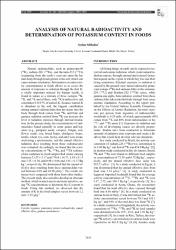| dc.description.abstract | Natural radionuclides, such as potassium-40 (K-40), radium-226 (Ra-226), and thorium-232 (Th-232) originating from the earth's crust can enter the human body through foods grown in the soil, which can cause internal it-radiation. Information on radioactivity concentrations in foods allows us to assess the amount of exposure to radiation through the diet. K, a vitally important mineral for human health, is found in nature as a mixture of three isotopes K-39, K-40, and K-41 and of these, only K-40 is radioactive and constitutes 0.0117% of natural K. Because natural K is abundant in the soil, the biggest contribution among natural radionuclides that are taken into the body through food comes from K-40. and beta and gamma radiation emitted from K-40 can increase the level of radiation exposure through internal irradiation. In the present study. the concentrations of radionuclides found naturally in some grains and legumes (e.g., pumpkin seeds, cow-peas, bulgur, sunflower seeds, rice, broad beans, chickpeas, beans, lentils, wheat, rye, corn, barley, and oats) were measured using a spectrometer, and the annual effective radiation dose resulting from these radionuclides was evaluated. Accordingly, we found that the activity concentrations of K-40, Ra-226. and Th-232 radionuclides contained in food samples had values varying between 33.27 +/- 5.17 and 370.4 +/- 16.73, 1.19 +/- 0.18 and 3.55 +/- 0.34, and 0.98 +/- 0.06 and 3.65 +/- 0.37 Bq kg(-1), respectively. We determined that the annual effective dose resulting from these radionuclides varied between 0.09 and 49.98 mu Svy(-1). The results obtained were compared with those from other studies. The present study also aimed to develop an alternate method, which is much easier and more sensitive, using K-40 concentrations to determine the K content in foods. Using this method, we observed that the amount of K in the food samples varied between 1.2 and 11.93 gkg(-1) | en_US |


















